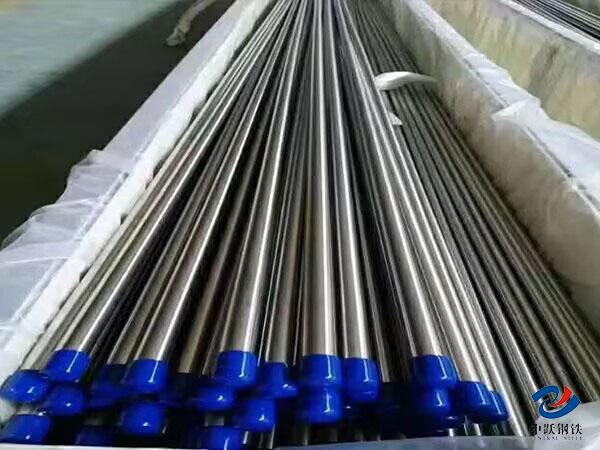ASTM A270 Sanitary stainless Steel pipe is the standard specification for welded seamless, heavy cold work welded austenitic and ferritic stainless steel sanitary pipe. The ASTM A270 standard applies to three types of sanitary pipe, including seamless and welded ERW, EFW stainless steel pipe types.
ASTM A270 sanitary stainless steel pipe is mainly used in the food industry and dairy industry, bioprocessing equipment, etc., its surface has a special finish.

1. Manufacturing process
ASTM A270
stainless seamless steel pipe is manufactured using a seamless process, which does not involve welding process, this process can ensure that the overall structure of the pipe uniform, thereby eliminating possible defects or micro-cracks due to the weld, improve the overall durability and corrosion resistance of the pipe.
Heat treatment process: Except for a few special materials, the conventional practice is to heat the raw material to at least 1900°F (about 1040 ° C) and then quickly quench with water or complete the heat treatment by other rapid cooling methods. This process can improve the grain structure of the material, increase the tensile strength and corrosion resistance, while ensuring good ductility and consistency of the pipe.
Heavy cooling (for some pipes) : Although the seamless pipe itself is not welded, for some more demanding applications, heavy cooling can be performed on the basis of the welded pipe, that is, at least 35% of the wall thickness is reduced after the pipe is welded, and then the final annealing treatment is carried out to further improve mechanical properties and surface quality.
2. Chemical composition
ASTM A270 has strict requirements for chemical composition to ensure that the pipe has adequate corrosion resistance, strength, and characteristics suitable for use in the sanitary field.
Main component indicators:
Carbon (C) : For austenitic stainless steel, the carbon content is usually required to be no higher than 0.08%, and it is even lower (about 0.035%) in low-carbon versions (such as 304L, 316L) to avoid carbide precipitation leading to intergranular corrosion.
Nickel (Ni) and chromium (Cr) : These two elements are the key to determining corrosion resistance and stability of stainless steel. Different grades (such as 304, 316, etc.) have different requirements for nickel and chromium content to ensure that the pipe can show excellent corrosion resistance in various corrosive media.
Other elements: Also including manganese, silicon, phosphorus, sulfur, etc., all have the maximum allowable content limit to ensure the overall chemical stability and performance consistency of the material.
3. Mechanical properties
Tensile Strength: A certain minimum value is required (for example, it is usually above 75 ksi for grade 304 stainless steel, that is, about 515 MPa) to ensure that the pipe will not break due to excessive force during use.
Yield Strength: Specifies the minimum stress required before the material begins to produce permanent deformation (for example, it is usually above 30 ksi for grade 304 stainless steel, that is, about 205 MPa) to ensure that the pipe deforms during use.
4. Size range and tolerance
Size range: ASTM A270 is suitable for tubing with an outer diameter of up to 12 inches (304.8 mm). Common seamless tube sizes are mostly used for applications with smaller diameters (e.g. 1/2 "to 2 1/2"), but the standard allows larger tube sizes to be produced when necessary.
Tolerance:
Outer diameter tolerance: The allowable deviation values vary from 0.005 "to 0.050" depending on the diameter of the pipe and the wall thickness.
Wall thickness tolerance: The actual wall thickness of the pipe shall not deviate from the specified value by more than 12.5%.
Length tolerance: Usually specifies the positive and negative allowable deviations of the length to ensure the accuracy of the product fit in the system.
5. Application field
Food Industry:
Due to its seamless construction and stringent surface treatment requirements, ASTM A270 stainless steel seamless tubing is ideal for the food, dairy and beverage industries. The smooth inner wall without welds helps prevent the accumulation of bacteria and mold, and ensures the hygienic safety of the fluid transmission system.
Pharmaceutical Industry:
In the pharmaceutical and biotechnology sectors, there are higher requirements for the purity, corrosion resistance and mechanical properties of pipes. ASTM A270 provides additional pharmaceutical grade standards upon customer request, ensuring that products meet extremely high hygiene standards.
Chemical and Other Applications:
In addition, ASTM A270 tubing can be used in some chemical processes, especially where corrosion resistance and high temperature resistance are required.
Conclusion
ASTM A270 seamless stainless steel tubing provides high quality tubing solutions for food, beverage, pharmaceutical and other industries with high hygiene and corrosion resistance requirements through its rigorous manufacturing process, precise heat treatment process, tightly controlled chemical composition and mechanical properties, and clear size ranges and tolerances. The weld-free construction and excellent surface quality of these pipes ensure long-term stable operation in demanding application environments, thus meeting the stringent product safety, hygiene and performance requirements of various industries.
